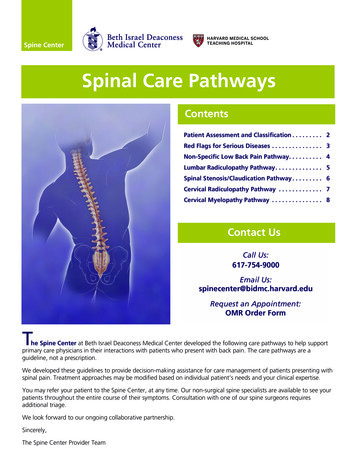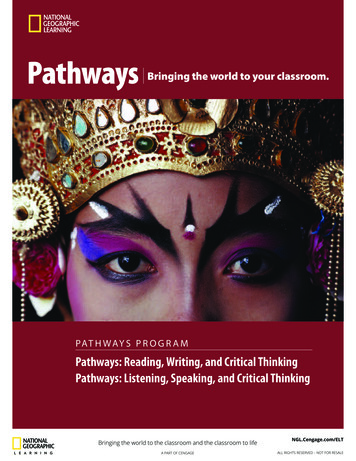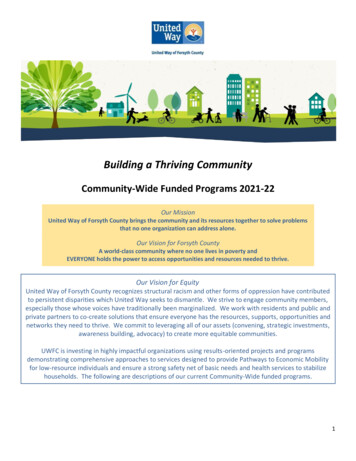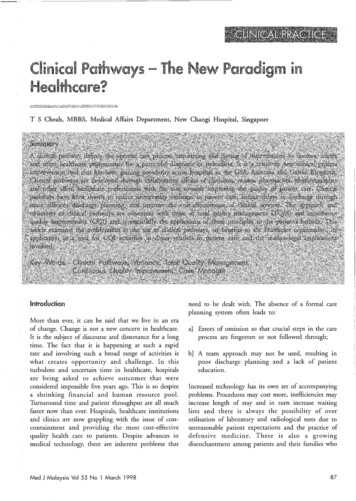
Transcription
Hoeve et al. Systematic Reviews(2020) EARCHOpen AccessEffects of oncological care pathways inprimary and secondary care on patient,professional and health systems outcomes:a systematic review and meta-analysisJolanda C. van Hoeve1,2*, Robin W. M. Vernooij3,4, Michelle Fiander5, Peter Nieboer6, Sabine Siesling1,2 andThomas Rotter7AbstractBackground: Pathways are frequently used to improve care for cancer patients. However, there is little evidenceabout the effects of pathways used in oncological care. Therefore, we performed a systematic review and metaanalysis aiming to identify and synthesize existing literature on the effects of pathways in oncological care.Methods: All patients diagnosed with cancer in primary and secondary/tertiary care whose treatment can becharacterized as the strategy “care pathways” are included in this review. A systematic search in seven databaseswas conducted to gather evidence. Studies were screened by two independent reviewers. Study outcomesregarding patients, professionals, and system level were extracted from each study.Results: Out of 13,847 search results, we selected 158 articles eligible for full text assessment. One hundred fiftystudies were excluded and the remaining eight studies represented 4786 patients. Most studies were conducted insecondary/tertiary care. Length of stay (LOS) was the most common used indicator, and was reported in fivestudies. Meta-analysis based on subgroups showed an overall shorter LOS regarding gastric cancer (weighted meandifference (WMD)): 2.75, CI: 4.67 to 0.83) and gynecological cancer (WMD: 1.58, CI: 2.10 to 1.05). Costswere reported in six studies and most studies reported lower costs for pathway groups.Conclusions: Despite the differences between the included studies, we were able to present an evidence base forcancer care pathways performed in secondary/tertiary care regarding the positive effects of LOS in favor of cancercare pathways.Systematic review registration: PROSPERO CRD42017057592.Keywords: Care pathways, Clinical pathways, Integrated care pathways, Care maps, Oncology, Cancer, Systematicreview* Correspondence: j.c.vanhoeve@utwente.nl1Department Health Technology & Services Research, University of Twente,Enschede, the Netherlands2Netherlands Comprehensive Cancer Organisation (IKNL), Utrecht, theNetherlandsFull list of author information is available at the end of the article The Author(s). 2020 Open Access This article is licensed under a Creative Commons Attribution 4.0 International License,which permits use, sharing, adaptation, distribution and reproduction in any medium or format, as long as you giveappropriate credit to the original author(s) and the source, provide a link to the Creative Commons licence, and indicate ifchanges were made. The images or other third party material in this article are included in the article's Creative Commonslicence, unless indicated otherwise in a credit line to the material. If material is not included in the article's Creative Commonslicence and your intended use is not permitted by statutory regulation or exceeds the permitted use, you will need to obtainpermission directly from the copyright holder. To view a copy of this licence, visit http://creativecommons.org/licenses/by/4.0/.The Creative Commons Public Domain Dedication waiver ) applies to thedata made available in this article, unless otherwise stated in a credit line to the data.
Hoeve et al. Systematic Reviews(2020) 9:246BackgroundCare pathways are also known as “integrated care pathways,” “clinical pathways,” “critical pathways,” or “caremaps” [1]. Care pathways are tools to guide evidencebased healthcare and have been implemented since the1980s [2]. Care pathways provide a means to improvemultidisciplinary communication and care planning, including primary and secondary/tertiary care. Further,pathways aim to improve communication between clinicians and patients as well as patient satisfaction [3]. Inaddition, care pathways are described to have a positiveimpact on quality of care, efficiency, and teamwork [4,5]. Rotter et al. [6] conducted a systematic review on theeffects of clinical pathways and concluded that clinicalpathways are associated with reduced in-hospital complications and improved documentation without negatively impacting on length of stay and hospital costs.Although care pathways are frequently applied in cancercare, the evidence of its effects is often limited. Furthermore, most study designs which were used to evaluatepathways were relatively weak. To our knowledge, a systematic review of the effects of pathways in cancer careis not available [7].Cancer care is complex and relies upon careful coordination between multiple healthcare organizations and providers. Technical information exchange and regularcommunication flow between all those involved in treatment(including patients, general practitioners, specialist physicians, and other specialty disciplines) is needed [8]. Therefore, care pathways are often used in cancer care and areseen as a method to provide patient-centered care, reducewaiting times, and improve quality of cancer care [9, 10].The aim of this systematic review is to assess the effects ofoncological pathways according to an unambiguous definition of cancer care pathway in studies providing a high levelof evidence. In this systematic review, effects of cancer carepathways were assessed in comparison with usual care. Inaddition, an overview of the outcome measures regarding patients, professionals, and system level will be presented. Because cancer care is characterized by coordination andmultidisciplinary communication within and between healthcare organizations, we searched for literature in primary aswell as secondary/tertiary healthcare. Furthermore, information about the implementation of oncological care pathwayswas assessed. By conducting this systematic review andmeta-analysis, we aimed to present the available high evidence in a substantiated and concise way, in order to improve the current evidence base regarding the effects ofoncological care pathways.Page 2 of 15randomized studies (NRS), controlled before-after studies (CBA), and interrupted time series studies (ITS), aswell as economic evaluations (cost-effectiveness analyses,cost-utility analyses and cost-benefit analyses, cost analysis, and comparative resource utilization studies),where available. Based on the suggested study designs ofthe Cochrane Effective Practice and Organisation ofCare (EPOC) Group for inclusion in reviews, retrospective cohort studies, prospective cohort studies,cross-sectional studies, and case-control studies wereexcluded [11]. An additional file shows an overviewof the inclusion criteria for this systematic review (seeadditional file 1).Types of participantsEligible participants for inclusion in this systematic review were patients in primary and secondary/tertiarycare which includes the coordination and continuity ofhealthcare as patients transfer between different locations or different levels of care. As potential patients, weconsidered all patients of every age and diagnosed withevery type of cancer in primary and secondary care/tertiary care.Types of interventionsIn this review, cancer care pathways were compared tousual care or care and treatment given to patients in acontrol setting. For the purpose of this review, we willdefine usual care as treatment determined at the discretion of the attending healthcare professional. This caremay present the best current care, and may also behighly variable across different settings. Due to the different terminology used for cancer care pathway, we applied the definition of clinical pathways based on fouroperational pathway criteria: (1) multidisciplinary (twoor more clinical professions involved), (2) protocol or algorithm based (i.e., structured plan/treatment-protocolor algorithm), (3) evidence based or based on practiceguidelines, and (4) aiming to standardize cancer care[12]. Every pathway characteristic could be met as (1)“yes” criterion; (2) “not sure” because of poor reportingor when the authors did not reply to our emails andphone calls and therefore we were not able to retrievemore information about the study or (3) “criterion notmet.” If one or more pathway criteria was not met, weexcluded the study. In the “Results” section, additionalinformation relating to the included studies and differences between the studies is presented.Types of outcome measuresMethodsTypes of studiesWe limited our study selection to the following studydesigns: randomized controlled trials (RCT), non-Every measured patient, professional, and system leveloutcome was considered for inclusion. Patient outcomesinclude (in-patient) mortality, mortality at the end offollow-up, re-admissions (hospital setting), (in-hospital)
Hoeve et al. Systematic Reviews(2020) 9:246complications, hospital admissions, adverse events, discharge destinations, performance status, patient satisfaction, quality of life, and absence from work. Professionaloutcomes include quality measures appropriate to thespecific aim of the care pathway, staff satisfaction, teamfunctioning, guideline adherence, and adherence toevidence-based practice. System level outcomes includelength of stay, waiting times, costs, and hospital charges.Furthermore, any reported measure regarding implementation strategies and methods were also assessed.Information sources and search strategySystematic searches were performed in the Cochrane Library, Medline (1946-2019), Embase (1946-2019), Cinahl(1981-2019), Lilacs, ClinicalTrials.gov, and the WorldHealth Organization International Clinical Trials Registry Platform, including conference abstracts. Becausethis systematic review aimed to present evidence regarding the effects of oncological care pathways, our literature search focused on “research” rather than “qualityimprovement.” Furthermore, grey literature wassearched in Open Grey, the Grey Literature Report(1996–2017), and Open Clinical. Also organizationalwebsites and professional organizations related to carepathways and implementation were assessed (EuropeanPathway Association, National Health Service England,The National Institute for Health and Care Excellence(NICE), Cancer Council Australia, American Society ofClinical Oncology (ASCO), as well as the websites of:International Journal of Integrated care and Journal ofClinical Pathways).Moreover, we employed citation tracking and examined included studies and previous reviews. We alsocontacted investigators to identify any study missed bythe electronic searches. The most recent searches wereconducted on July 1, 2020. Two reviewers independentlyscreened all titles and abstracts (JvH, RV), using Covidence (www.covidence.org). A third reviewer (TR) wasavailable for consultation in the case of disagreementsbetween the two reviewers. The potentially relevantstudies were further examined using full-text copies. Alldatabases were searched from the date of inception forward with neither date nor language limits. See for thecomplete search strategy, additional file 2.Summary of the search strategyPathway: Critical pathway, clinical pathway, patient care pathway,pharmacotherapeutic pathway, therapeutic pathway, treatmentpathway, care plan, structured care, intensive management care, carealgorithm, treatment algorithm, therapeutic algorithm, standardized(patient) care, standardized treatment, (care) map, process mapPage 3 of 15Information sources and search strategy (Continued)Summary of the search strategyGuideline: Interdisciplinary guideline, cross disciplinary guideline,multidiscipline guideline, team guideline, standardized guideline,practice guidelineHealth professional: Clinician, provider, professional, doctor, nurse, familydoctor, family physician, family practitioner, GP, practitioner, physician,hospital, pharmacy, primary care, regulatory, teamIntervention: Intervention study, intervention care, intervention health,demonstration project, pre-test, post-test, improvement, impact, individualized, interdisciplinary, multicomponent, multidisciplinary, multifaceted,multimodal, personalized, standardized, usual careStudy design: Randomized controlled trial, (controlled) clinical trial,placebo trial, quasi-experiment, experimental method, experimentalstudy, experimental design, (interrupted) time series, multicentre study,controlled before-after study, interrupted time series analysis, evaluationstudy, prospective studies, retrospective study, meta-analysis, pilot project, systematic review, meta-nalysis, scoping review, concept analysisData collection processFrom every included study, we extracted data stics,interventions characteristics, and outcomes.Hospital costs and charges were assessed andcalculated for the individual studies. Cost and chargesdata were calculated in US for the common price year2016 by using the “CCEMG-EPPI-Centre CostConverter” [13]. This Cost Converter is a web-based toolthat can be used to adjust and estimate of cost expressedin one currency and price year to a target currency orprice per year [13].Statistical analysisFor calculating the pooled effects estimate, calledweighted mean difference (WMD), we used ReviewManager from the Cochrane Collaboration [14]. Toassess the comparability of the results from individualstudies and included subgroups, we used the statistic forquantifying inconsistency: I2 [(Q df)/Q] 100%) [15].We considered an overall test-value greater than 60% toserve as evidence of substantial heterogeneity of a magnitude where statistical pooling is not appropriate [15].We used a random effects model since the modelestimates the effect with consideration to the variancebetween studies, rather than ignoring heterogeneity byemploying a fixed effects model.Subgroup analysis based on differences in the setting,on the risk of bias of the studies, and on the age of thestudy population was not possible because thesecharacteristics were not distinctive enough between thestudies to form different subgroups.Cancer: Oncology, neoplasm, carcinoma, malignant, tumorOncology: Medical oncology, radiation oncology, surgical oncology,oncologist, radiation oncologistQuality assessmentTwo reviewers independently assessed the quality of thestudies (JvH, RV). Therefore, we adhered to the
Hoeve et al. Systematic Reviews(2020) 9:246validated criteria suggested by the Effective Organisationof Care Group (EPOC) and defined three risk of biasclasses: class I (low risk of bias), class II (moderate riskof bias), and class III (high risk of bias) [16]. A thirdreviewer was available for consultation in case ofdisagreements between the two reviewers (TR). Toappraise the methodological quality of the included costevaluations, the Evers checklist was used, which isrecommended for Cochrane Reviews [17].Dealing with missing dataIf a study did not provide information about the standarddeviation, this was calculated based on the reported p valueand mean difference. For calculating the standard deviationof the mean, we used the Revman Calculator culator). By usingthis calculator, the assumption was made that the standarddeviations of outcome measurements are the same in bothstudy groups.For calculating the mean as well as the standarddeviation from the reported median and range, we usedthe mean variance calculator (http://www.comp.hkbu.edu.hk/ xwan/median2mean.html)Page 4 of 15Quality assessmentBased on the validated criteria suggested by the EffectiveOrganisation of Care Group (EPOC) [16], all studieswere assessed as “high risk of bias,” except for twostudies [18, 19]. In an additional file, the results of therisk of bias assessment are shown (see Additional file 6).The results of the cost evaluation according the Everschecklist [17] is presented in Additional file 7.Results of studies conducted in the secondary/tertiaryhealthcare (hospital care) settingThe majority of the included studies (seven studies)were conducted in the setting of secondary healthcare,within hospitals or in oncology centres [18–24]. Thesestudies represented 1494 patients.Study characteristicsIn this paragraph, a description in given of the followingstudy characteristics: study designs, tumor location,sample size, country, and healthcare setting. In Table 1,the study characteristics of the included primary studiesincluded are presented.Study designsResultsSearch resultsThe specialized search strategy led to 13,870 results.After removing duplicates, all of the 13,847 titles andabstracts were screened for inclusion. The remaining158 possibly relevant studies were retrieved as full textarticles. Based on the full text assessment, 150 studieswere excluded. The majority of the excluded studies didnot meet our study design criteria (79 studies). Inaddition, a number of studies compared differentmedical treatments and medication, the intervention didnot meet our definition of cancer care pathways, orinformation was lacking (25 studies). Other excludedstudies did not include cancer patients (15 studies), acontrol group was missing (15 studies), provided only anabstract or protocol (15 studies), full-text was not available (3 studies), or the outcomes described did notmatched our inclusion criteria (1 study). Finally, eightstudies matched our methodological requirements. In anadditional file, the PRISMA flow diagram is presented(see Additional file 3). The excluded full text studies andthe reason for exclusion are listed in Additional file 4.For the references of all excluded full text studies, seeAdditional File 5.Below, we present the studies conducted in thesecondary/tertiary healthcare setting separately from thestudy conducted in both primary and secondaryhealthcare, because the settings in which the studieswere performed, intervention characteristics, andoutcomes differed greatly.The specification of the study designs of the includedstudies were based on the description of the CochraneEffective Practice and Organisation of Care (EPOC)Group [11].We included two studies which applied randomizedstudy designs [18, 19]. In these studies, patients wererandomized to either a pathway group or a non-pathwaygroup. Two studies used an interrupted time series studydesign (ITS); in these studies, a pre-pathway group wascompared to two or more pathway groups [21, 22]. Inone study, pathway groups at 12 and 36 months afterimplementation were compared to a pre-pathway group[21], and in the other study a pre-pathway group andpathway groups at 6, 12, and 18 months after implementation were used [22].Furthermore, in three studies, a non-randomized controlled trial study design was applied [20, 23, 24]. Inthese studies, patients in the non-pathway group received general care, and simultaneously patient in thepathway group were managed based on the pathway. Inone study, a historical control group was compared withtwo other groups; a pathway group and a non-pathwaygroup [20].Tumor locationIn the articles, patients with different tumors werestudied: three studies described the effects of pathwaysfor head and neck cancer [19–21]. Other studiespresented the results of pathways for gastric cancer [18,23], gynecological cancer [22], and breast cancer [24].
Hoeve et al. Systematic Reviews(2020) 9:246Page 5 of 15Table 1 Study characteristics of included primary studiesStudy IDStudy designTumor locationSampleSizeCountry Setting1 Chen et al.2000 [20]Non-randomized controlled triala(with a historical control group)Unilateral neck dissection190USA2 Dahl et al.2017 [25]Non-randomized controlled triala(with a historical control group)Cancer patients (colorectal, lung,melanoma, breast, prostate, and other)3292Denmark Danish hospitals, primaryand secondary care3 Gendronet al. 2002[21]Interrupted time series studyaHead and neck cancer surgery212USATertiary care academicmedical center4 Ghosh et al.2001 [22]Interrupted time series studyaHysterectomy cervical or endometrialcancer151USAAcademic Medical Center,tertiary care5 Jeong et al.2011 [23]Non-randomized controlled trialaTreatment of gastric cancer (early vs.advanced; non-CP vs. CP)631KoreaUnclear, secondary care6 Kiyama et al.2003 [18]Randomized controlled trialGastric cancer85JapanNippon Medical SchoolHospital, secondary care7 Tastan et al.2012 [24]Non-randomized controlled trialaBreast cancer69TurkeyMilitary Medical Academy,secondary carePain screening and treatment in headand neck cancer156UKHospital, secondary care8 Williams et al. Randomized controlled trial2015 [19]Academic cancer Center,secondary/tertiary careUSA United States of America, CP care pathway, UK United KingdomaStudy design is not mentioned in the article; specification is based on the Cochrane study designsSample sizeThe number of included participants varied, and rangedfrom almost 70 patients to more than 600 patients [18–24].CountryThree studies were conducted in Korea, Japan, andTurkey [18, 23, 24]. In addition, three studies wereperformed in the USA [20–22], and one in the UK [19].SettingThree studies were conducted in general and nonacademic hospitals or oncology centres [18, 19, 24].Other studies were performed in an academic hospital[20–22]. In one study, the setting was not clearly reported [23].Population characteristicsThe population characteristics of the study groupsincluded in the studies was listed in Table 2. All studies,expect one [22], reported patient characteristics on genderand age. Two studies reported also characteristics aboutsocioeconomic status [21, 24].Intervention characteristicsIn this paragraph, the intervention characteristicsreported in the studies were described: study groups,intervention, and care pathway. See Table 3 for moredetailed information.The specific interventions regarding the pathwaysdescribed in the included studies showed considerablevariation. Most studies focused on pathways for theperioperative phase in order to guide surgicalmanagement [18, 20–24], and one study investigatedpain management [19]. In the studies focusing on forsurgical care, the following key components whichwere addressed in these pathways were described:nutrition and diet [18, 20, 22–24], diagnosticmodalities, and laboratory tests [20–24]; medication[18, 20, 23, 24]; patient education [18, 22, 24];preoperative consultation and visits [20, 23, 24];drains [21, 23]; activity [20, 24]; clinical proceduresand treatment [20, 24]; discharge planning orinstruction [20, 24]; assessment and preadmissiontesting and evaluation [20, 23]; and psychosocialsupport and education [20, 24]. Other componentswhich were mentioned in one study only:performance status, outcome criteria, follow-up criteria, and follow up care [20]; pain management andpain control; and deep vein thrombosis prophylaxis[22], preoperative bowel preparation and fasting, andremoval of nasogastric tube [23], removal of a catheter and mobility [18].The study included in this review investigating painmanagement, included an initial consultation with acontrol pain doctor and weekly follow up sessions [19].In addition, in three studies the pathway waspresented in detail providing a description of thepathway as well as a figure of the pathway [20, 23, 24].Further, one study presented a pathway for the hospitalstaff as well as a pathway for patients [23]. In the otherstudies, no detailed information about the pathway wasavailable.
Hoeve et al. Systematic Reviews(2020) 9:246Page 6 of 15Table 2 Population characteristics of included primary studiesStudy IDStudy groupsGender(male vsfemale)AgeSocioeconomic status1 Chen et al.2000 [20]Historical control groupnonpathway groupPathway group76% vs. 24% 58 years64% vs. 36% (median)73% vs. 27% 59 years(median)60 years(median)2 Dahl et al.2017 [25]Before implementationAfter implementationtotalAfter implementationpathway referredAfter implementationnon-pathway referred45% vs. 55%52% vs. 48%49% vs. 51%54% vs. 46%11.3/14.8/25.3/ No information 4/25.5/33.2/24.6a7.3/13.3/24.6/33.1/21.6a3 Gendronet al. 2002[21]Control group (prepathway)1 year after pathwayimplementation3 years after pathwayimplementation71% vs. 29%79% vs. 21%73% vs. 27%65 years(median)61 years(median)60 years(median)No information availableSmoking (yes): 96%; alcohol use (yes): 75%Smoking (yes): 90%; alcohol use (yes): 73%Smoking (yes): 90%; alcohol use (yes): 54%4 Ghosh et al. Separate groups for2001 [22]cervical and endometrialcancerPreintervention groupPostintervention groupPostintervention groupPostintervention groupNo patients characteristics were reported. Patients were matched for age, comorbid conditions, andstage of disease only.5 Jeong et al.2011 [23]Non care pathway groupearly gastric cancerPathway group earlygastric cancerNon care pathway groupadvanced gastric cancerPathway group advancedgastric cancer71% vs. 29%64% vs. 36%69% vs. 31%65% vs. 35%59.7 (mean)58.2 (mean)59.1 (mean)59.3 (mean6 Kiyamaet al. 2003[18]Traditional care groupClinical pathway group66% vs. 34%62% vs. 38%66.8 yearsNo information available(mean; 12.9)63 years(mean; 12.1)7 Tastan et al. Control group2012 [24]Clinical pathway groupNoinformationavailable53.2 (mean; 12.3)51.7 (mean; 11.3)Marital status (married vs. single): 82.4% vs. 17.6; ownership child (no vs.yes): 11.8% vs. 88.2; education (primary/secondary/high school/college orhigher): 8.8%/50%/17.6%/23.6%; occupation (yes vs. no): 32.4% vs. 67.6%.Marital status (married vs. single): 82.9% vs. 17.1; ownership child (no vs.yes): 2.9% vs. 97.1; education (primary/secondary/high school/college orhigher): 11.4%/45.7%/28.6%/14.3%; occupation (yes vs. no): 17.1% vs.82.9%.8 Williamset al. 2015[19]64% vs. 36%66% vs. 34%58 years(mean; range19-80)60 years(mean; range39-82)No information availableUsual care groupIntervention groupNo information availableThe information about age was reported in the following categories: 18–44 years; 45–54 years; 55–64 years; 65–74 years; 75 yearsaOutcomesThe most frequently used patient outcomes reported inthe included studies were complications [18, 20, 21] andreadmission [20–22]. Other reported patient outcomeswere patient satisfaction [19, 24], patient anxiety [19,24], morbidity [18], and quality of life [24]. However,these quality outcomes measures were not comparablebetween the studies.Professional outcomes such as staff satisfaction andteam functioning were not reported in the includedstudies. Furthermore, LOS was the most common usedindicator for system level outcomes and was reported in
Hoeve et al. Systematic Reviews(2020) 9:246Page 7 of 15Table 3 Intervention characteristics of included primary studiesStudy ID Study groupsInterventionCareOutcomespathwaya1 ChenHistorical control group (prepathway, Sep 1993–et al.Dec 1994)2000 [20] Contemporaneous nonpathway group (Sep1996-Aug 1998)Clinical pathway group (Sep 1996-Aug 1998)Patients underwent the same surgical procedureduring the time of implementation, but were notmanaged based on the pathway. The treatedphysician decided solely to place patients on thepathway.The neck dissection pathway was presented in a MeetsLength of hospitaltabular format and consists of the followingcriteria 1– stay (median)aspects: assessment/evaluation, consult,4Complicationsdiagnostic test, treatment, medication,Readmissionperformance status/activity, nutrition, teaching/Costs of carepsychosocial, discharge planning, outcome criteriaand follow-up criteria. The activities were described for the initial evaluation, preoperative visit,and same day admit surgery.2 DahlBefore implementation (Sep 2004–Aug 2005)et al.After implementation total (May–Aug 2010)2017 [25] After implementation pathway referred (May–Aug 2010)After implementation non-pathway referred(May–Aug 2010)The framework of the Danish cancer pathwaysMeetsPatientincludes three different descriptions of thecriteria 1– dissatisfaction withpathway: a flowchart, a narrative text and a table 4long term waitingproviding an organizational overview. A pathwaytimesin the Danish context is a standardized pathwaythat most patients suspected of cancer will beable to follow. It describes the patient’s pathwayfrom clinical suspicion of a certain cancer throughdiagnostic procedures and treatment. Thepathway describes the medical procedures, thenecessary organization encompassing bothprimary and secondary sectors of the healthsystem, and timeframes in accordance with thepolitical agreement. Main emphasis in thepathways are on information to be given to thepatient, explicit identification of the responsiblehealth professional or department in all phases,procedures for referral, description ofmultidisciplinary teams in each pathway as aforum for decisions on diagnosis andrecommended treatment, and timeframes of allphases. An example of a pathway is shown[Probst et al. 2012].3 Gendron Control group (pre-pathway) (1995)et al.1 year after pathway implementation (July 1996–2002 [21] July 1997)3 years after pathway implementation (1999)The pathway for patients undergoing majorMeetsLength of stayresection for upper aerodigestive tract cancer was criteria 1– (median, range)implemented in July 1996. The format for the4Readmissionpathway is a 1-page table containing a list ofComplication ratesgoals and interventions for each postoperativeHospital chargesday, followed by a page for each day on whichaccomplishments are recorded. When goals werenot met, the variances are recorded in detail onthe flow sheet.4 GhoshSeparate groups for cervical and endometrialet al.cancer:2001 [22] Preintervention group (Jan 1997–June 1998)Postintervention group (July 1998–Dec 1998)Postintervention group (Jan 1999–June 1999)Postintervention group (July 1999–Dec 1999)Care pathways for patients with gynecologicMeetsLength of hospitalmalignancies were developed based on thecr
Background Care pathways are also known as "integrated care path-ways,""clinical pathways,""critical pathways," or "care maps" [1].










